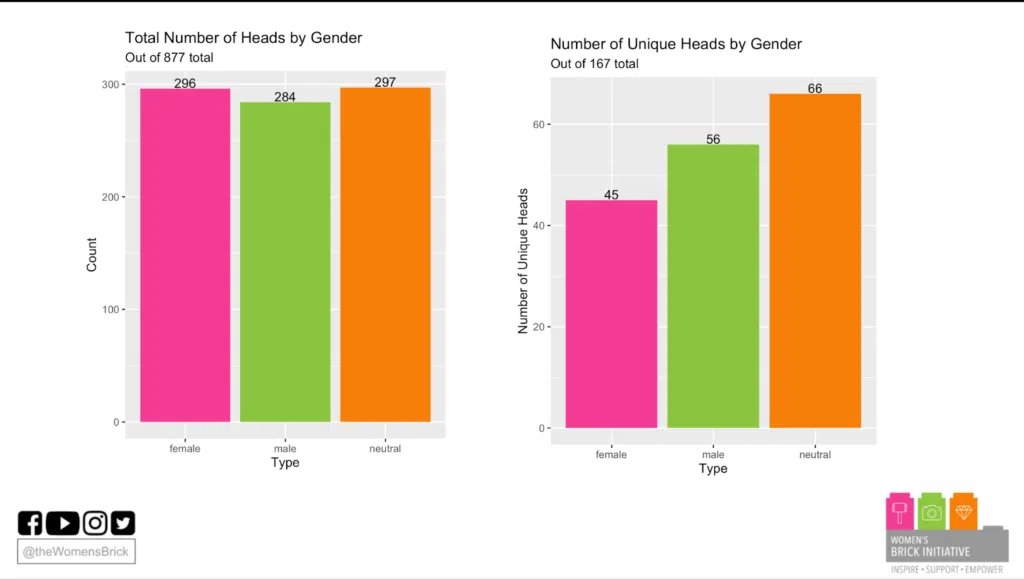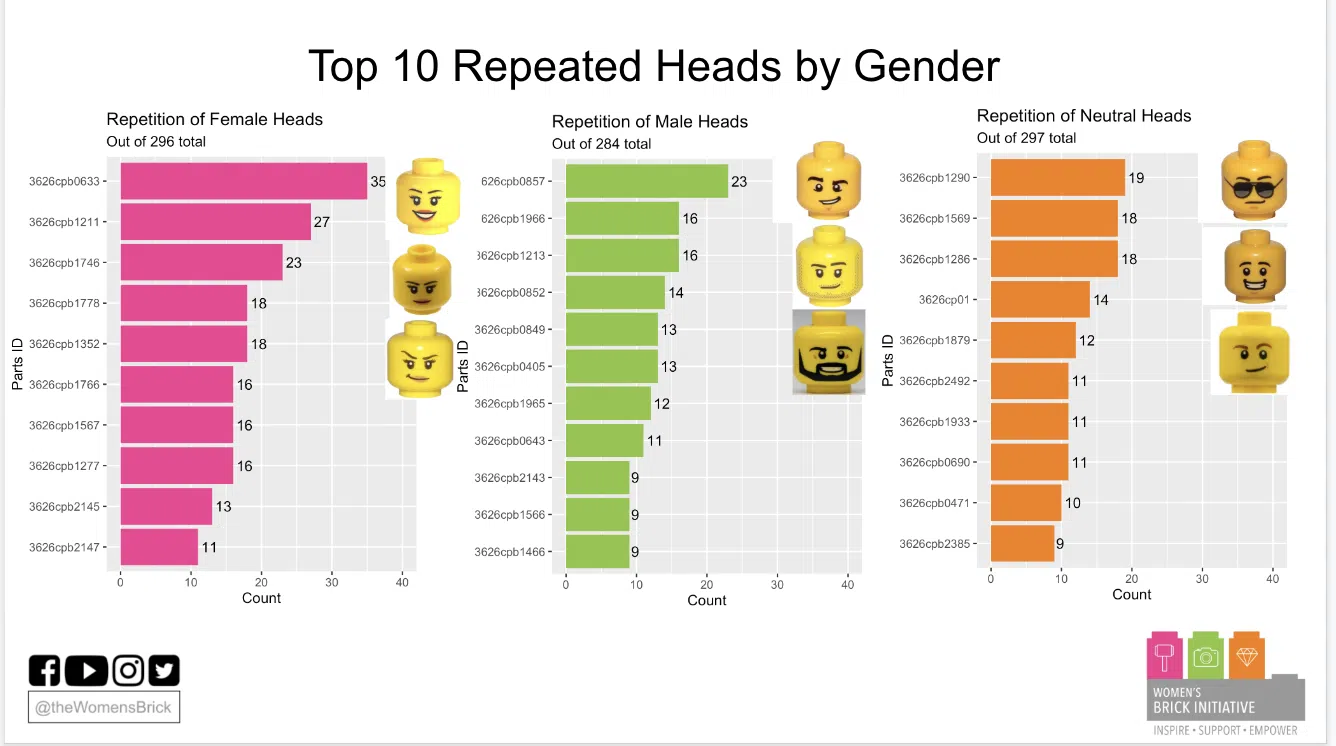What’s in a minifigure?
Have a feeling you’ve seen a “new” minifigure before? Chances are you probably have. LEGO has produced over 14,000 different minifigures over the years, and each new minifigure does not always have new individual parts. Existing parts are often mixed and matched to create new minifigs. For example, there may be five different minifigs that all have the same head design, yet they are different because they have different torsos, legs, or hair. LEGO does this in order to cut down on the costs of producing new parts, which is understandable, but is the way they choose which parts to repeat, how many times to repeat them, and where to repeat them gender-equitable?
After noticing that the same female head was used multiple times around 1998-2000 within the Town category, we began to suspect that female heads may be repeated more than male or neutral heads. In Part 1 of this analysis, we explored the repetition of this one female head in comparison to other heads within the same sets and found a drastic disparity between the variation in female heads as compared to male and neutral heads. This was for a time period some distance in the past, so this analysis will explore whether this trend continues in more recent years.

A major limitation of our previous analysis is that we chose the sets to analyze based on the fact that they contained the head we were interested in, which skewed the results such that this specific head appeared in significantly more minifigs than any of the other heads. Furthermore, our previous analysis dealt with sets mainly released between 1990-2010, so we were curious to know whether or not female heads are still being repeated more often than male or neutral sets in more recent years. In this subsequent analysis, we will explore repetition of heads by gender for all minifigs within the Town category released within the past five years (2017-2022).
The barchart on the left displays the distribution of male, female, and neutral heads across the 877 minifigs in the Town category released 2017-20221. It is notable that there is almost a perfectly even balance between male, female, and neutral heads. The Town category is one of the most gender-equitable categories, so it could be interesting to repeat this analysis using different themes. Expanding this analysis could help determine whether there are differences in head repetition frequency by gender when the male-female-neutral ratio is not as equitable as it is in the Town category.
Across the 877 total minifigs in Town, there were 167 unique heads (excluding baby and robot heads). As shown by the barchart on the right, 45 of these heads were female, 56 were male, and 66 were neutral. Clearly, female heads have the least variety of all gender categories.
Looking at the distribution of frequency of repetition per head by gender below, we can see that the distributions for male and neutral look very similar, with the most repeated head having a frequency of 23 for male and 19 for neutral. For female heads, we can see that the top few most repeated heads are repeated far more often than the top few male or neutral heads, with the most repeated female head having a frequency of 35.
Looking at the top 10 heads per gender category, the top 2 most repeated female heads have a frequency that is greater than any male or neutral head, but besides these couple of outliers, the frequency distribution is similar across all gender categories.
The boxplots below provide an alternative representation of the frequency distributions. Since boxplots show us the median and the outliers of each distribution more clearly, this representation shows more explicitly that the distributions are very similar except for the two outliers on the upper end for females. All three distributions have a median around 2 or 3. This means that if we were to choose a head from any gender at random, it would be a fairly good estimate to say that that head was repeated 2 or 3 times.
Overall, we do see a few female heads repeated more frequently than male or neutral heads even within the past five years. When we look at the frequency distributions as a whole, the disparity is not as pronounced. Thus, it seems that there are a few heads that are the go-to for female heads, while male and neutral heads have more variety.
This higher frequency of repetition for certain female heads is important to address because it sends two harmful messages:
- All (or many) females look the same, and
- Female minifigs are less important than male minifigs, and thus less worthy of investing the cost of producing new female heads.
Because of these important implications, we plan to expand this analysis to other subsets of minifigs outside of the Town category. Stay tuned for future posts looking at head repetition in Star Wars, Jurassic World, and Marvel characters as well as in minifigs representing specific cultures.
1 Gender Classification Criteria:
- Female if bricklink description included “female”
- Male if bricklink description included ” male”, “beard”, “moustache”, “goatee”, “sideburns” or “stubble”
- Neutral otherwise



1 comment
Lara Granger
Are you saying there are no bearded women?